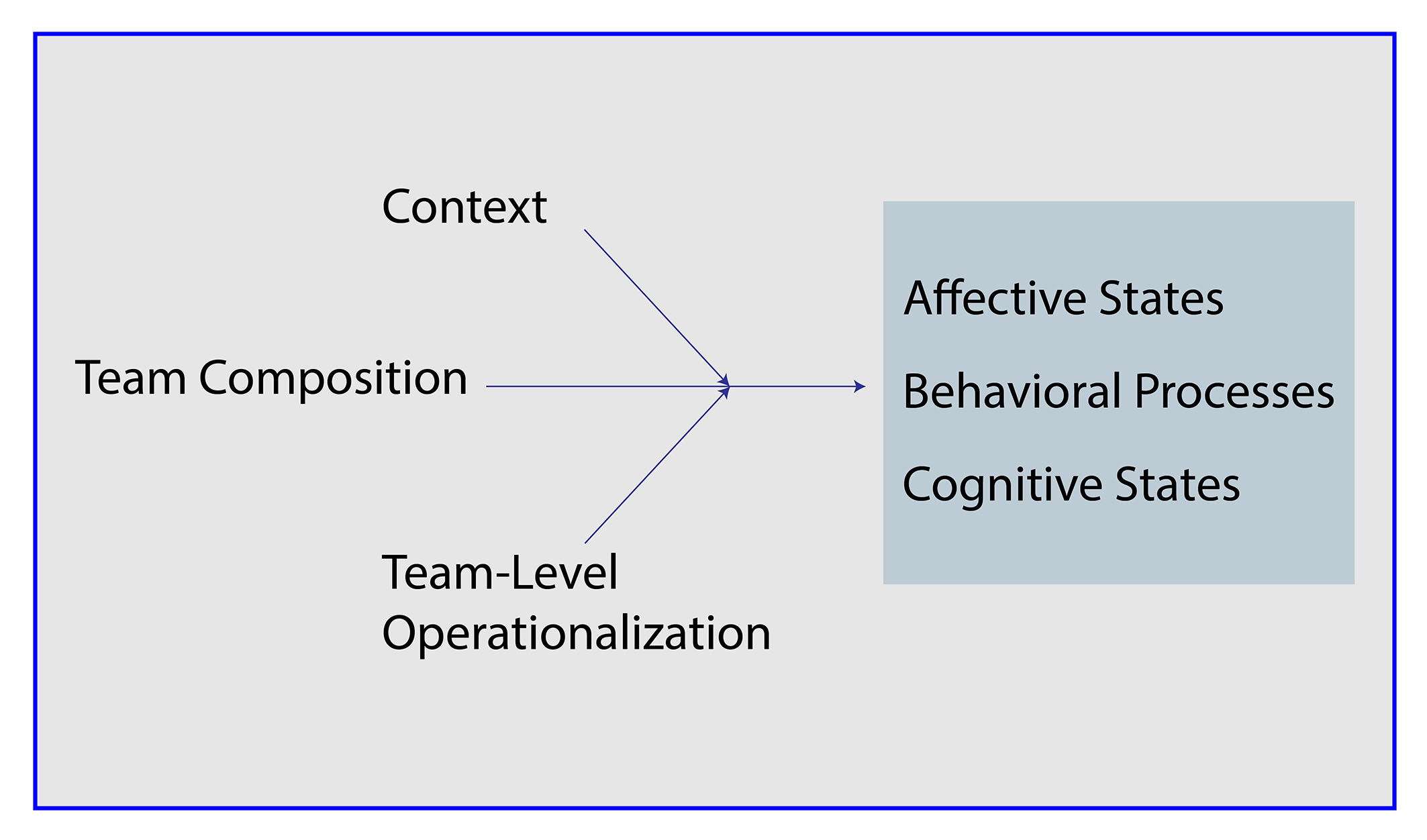Bell et al.’s (2018) model for Team Composition and the ABC’s of Teamwork Relationships
Bell et al. (2018) presented their model for team composition and the ABC’s of teamwork relationships. Composed of four fundamental concepts: team member attributes, operationalizations at the team level (e.g., diversity, team mean), the context, and temporal considerations (time).
Team Member Attributes
– Surface-level Attributes
– Deep-level Attributes
Surface-level Attributes
“These are readily detectable categories (e.g., age, sex, race) and easily accessible information (e.g., reputation, role) that shape how team members behave, think, and feel toward other team members.” (Bell et al., 2018, p. 351)
Deep-level Attributes
“As team members interact over time, their interactions are shaped by underlying psychological characteristics (e.g., personality traits, abilities, values, attitudes), referred to as deep-level attributes.” (p. 351)
Operationalizations at the Team Level
– Required for team
– Compositional
– Compilational
Operationalizations
Operationalizations should be selected that best match the team member’s attributes, as a team-level and not an individual-level phenomenon, that shape the team’s ABC’s (affective states, behavioral processes, and cognitive states).
Compositional
“Compositional processes are based on the assumption of isomorphism; team members’ contributions are proportionate, and all team members’ attributes (e.g., scores on conscientiousness) are weighted equally” (p. 352).
Compilational
“Compilational processes occur when team members’ attributes interact with those of other team members to create a qualitatively different team-level phenomenon” (p. 352).
Context
Context shapes team member relationships
1) Context shapes the salience of an attribute, which is particularly important for anticipating the influence of surface-level team composition variables on teamwork (van Knippenberg, De Dreu, & Homan, 2004). (p. 352)
2) Context can modify the relevance, value, and centrality of different aspects of team composition for teamwork (trait activation theory; Tett & Burnett, 2003). (p. 352)
3) Context can cue the desirability of behaviors, and generate a common perception and motivation (i.e., contribute to situational strenght; Mischel, 1977). (p. 354)
Internal and External Context
1) Internal context includes situational influences within the bounds of a team, such as the typical mode of communication, nature of the team’s tasks, and the structural dependence between team members (see Hollenbeck, Beersman, & Schouten, 2012). (p. 354)
2) External context includes influences, stimuli, or actors, which are mostly outside the control of the team (Maloney, Bresman, Zellmer-Bruhn, & Beaver, 2016). (p. 354)
Time
Team composition relates to the ABC’s of teamwork in a dynamic process that unfolds over time. (p. 354)

ABC’s of Teamwork Relationships
A – Affective and Motivational States
B – Behavioral Processes
C – Cognitive States
Affective and Motivational
“Affective and motivational states are team members’ feelings and attitudes toward the team and its tasks; examples include team cohesion, trust, emotion and mood, efficacy, and conflict.” (p. 349)
Behavioral
“Capitalizing on the talents and efforts of multiple team members takes teamwork. Teamwork involves team members’ interdependent behaviors that translate inputs (e.g., capabilities, materials, resources) into outputs (e.g., products; Marks, Mathieu, & Zaccaro, 2001), call team processes.” (p. 349)
Cognitive States
“Cognitive states represent the structure of knowledge organization, collective perception, and information acquisition; examples include team learning and shared mental models.” (p. 349)
References:
Bell, S. T. (2007). Deep-level composition variables as predictors of team performance: A meta-analysis. _Journal of Applied Psychology_, _92_(3), 595-615. https://doi.org/10.1037/0021-9010.92.3.595
Secondary References:
Hollenbeck, J. R., Beersma, B., & Schouten, M. E. (2012). Beyond team types and taxonomies: A dimensional scaling conceptualization for team description. Academy of Management Review, 37, 82–106.
Maloney, M. M., Bresman, H., Zellmer-Bruhn, M. E., & Beaver, G. R. (2016). Contextualization and context theorizing in teams research: A look back and a path forward. The Academy of Management Annals, 10, 891–942. http://dx.doi.org/10.1080/19416520.2016.1161964
Marks, M. A., Mathieu, J. E., & Zaccaro, S. J. (2001). A temporally based framework and taxonomy of team processes. Academy of Management Review, 26, 356–376.
Mischel, W. (1977). The interaction of person and situation. In D. Mag- nusson & N. Endler (Eds.), Personality at the crossroads: Current issues in interactional psychology. Hillsdale, NJ: Erlbaum.
Tett, R. P., & Burnett, D. D. (2003). A personality trait-based interactionist model of job performance. Journal of Applied Psychology, 88, 500 –517. http://dx.doi.org/10.1037/0021-9010.88.3.500
van Knippenberg, D., De Dreu, C. K., & Homan, A. C. (2004). Work group diversity and group performance: An integrative model and research agenda. Journal of Applied Psychology, 89, 1008–1022. http://dx.doi .org/10.1037/0021-9010.89.6.1008